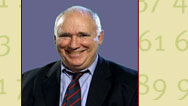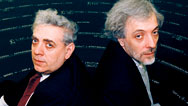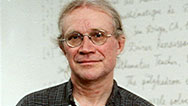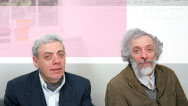Twin Prime Conjecture
- Posted 01.10.06
- NOVA scienceNOW
(This video is no longer available for streaming.) Prime numbers—those that can only be divided by themselves and one—bear a mystery. Why do primes tend to pair up? Five and seven, for example, are prime, as are 41 and 43, and 101 and 103. For millennia, mathematicians have wondered: Does this continue no matter how high one counts? As this video and its original song reveal, a mathematician has just given us an answer to this age-old enigma.
Transcript
TWIN PRIME CONJECTURE
PBS Airdate: January 10, 2006
ROBERT KRULWICH: Our next story concerns prime numbers. It's a mystery that's been around for 2,300 years, since the days of the great mathematician Euclid.
Now a prime number, for those of you who have forgotten, is a number which can only be divided by itself and one. And there is this curious thing about primes. They seem for some reason to clump together. So if you start with 5, you'll notice that 5 is very close to 7. And then the next prime's 11 right next to 13, and then 17 very close to 19. And Euclid wondered, well do they just go on like this clumping and clumping forever? No matter how high you count?
Well, a mathematician has just given us an answer. And we thought the answer so intriguing that it was worth a song. So here it is, "Euclid's Twin Prime Conjecture" performed by our singing reporter, Rob Morsberger, for an audience of mathematicians.
ROBERT MORSBERGER (Singing):
Prime is the numberThat is only divisible by itself and one.
They have no other factors,
Though they may have their detractors.
They are kind of fun.
MEL NATHANSON:
They have no detractors, everyone loves a prime.ROBERT MORSBERGER(Singing):
'Cause they like to come in pairs,with a number in between.
Just like 5 skip 7, 41 skip 43.
The name of our lecture, is "The Twin Prime Conjecture."
Primes will pair into infinity.
MAN:
11 skip 13.KEVIN O'BYRANT:
17 skip 19.ROBERT MORSBERGER (Singing):
Empirically we know,This pattern reappears, however high we count.
Will it keep on skipping just like this?
Or somewhere down the line
Will it peter out?
TOM MORGAN:
No, we think it's going to go on forever, but no one knows.ROBERT MORSBERGER (Singing):
Euclid first proposed this around 300 B.C.,But none's ever proved it, in all of history.
Well this year Daniel Goldston, from the U of San Jose,
Says the pattern will continue,
In this skippy kind of way.
MEL NATHANSON:
His results certainly suggest it.ROBERT MORSBERGER:
Goldston didn't prove the conjecture.CARLOS MORENO:
But it's a major advance.ROBERT MORSBERGER:
A major advance. He did show that primes appear close together.KEVIN O'BYRANT:
Kind of big skips.GREG CHUDNOVSKY:
Gaps.ROBERT MORSBERGER (Singing):
Gaps! A big step in the right direction.They like to come in pairs, with a number in between.
11 skip 13, 101 skip 103.
The name of our lecture,
Is "The Twin Prime Conjecture."
Primes will pair into infinity.
Credits
Twin Prime Conjecture
- Executive Producer
- Samuel Fine
- Executive Editor
- Robert Krulwich
- Senior Series Producer
- Vincent Liota
- Senior Producer
- Robe Imbriano
- Producers
- Julia Cort
Carla Denly
Robe Imbriano
Dean Irwin
Vincent Liota
Mary Robertson
Win Rosenfeld - Editors
- Ben Ehrlich
Nathan Hendrie
Robe Imbriano
Vincent Liota
Win Rosenfeld - Supervising Producer
- Andrea Cross
- Development Producer
- Kyla Dunn
- Program Editor
- Steve Trevisan
- Associate Producers
-
Anthony Manupelli
Mary Robertson
Win Rosenfeld
Ayo Babatunde
Shimona Shahi - Unit Manager
- Candace White
- Production Secretary
- Ayo Babatunde
- Compositing
- Yunsik Noh
- Production Assistant
- Robbie Gemmel
- Music
- Rob Morsberger
- NOVA scienceNOW Series Animation
- Edgeworx
- Camera
- Chris Borghesani
George Delgado
Brian Dowley
Tom Fahey
Vikram Gandhi
Robert Hanna
Michael Hunkley - Sound Recordists
- Paul Austin
Vikram Gandhi
Mike Karas
Dennis McCarthy
Gilles Morin
Alex Sullivan - Audio Mix
- John Jenkins
- Animation
- Mitch Butler
Edgeworx
Picket Design
Pie Design - Special Thanks
- Clifford Cunningham
Foxwoods Resort Casino
The Graduate Center at CUNY
Alex Meissner
Naturally Tasty Health Food
The New York Number Theory Seminar
The officers and crew of the NOAA ships Delaware II and Albatross IV
Jí¡nos Pintz
Salon Mario Russo
Cem Yildirim
Adam Zoghlin - Archival Material
- ABC News Video Source
Art. Lebedev Studio
Mike Brown, Caltech
Michael Brumlik
Jewel Webb Chambers
CNN
CORBIS Motion
Michael DiGiorgio, Worldwide Nature Artists Group
Denis Finnin, American Museum of Natural History
Richard Gibbe
Dennis Kunkel Microscopy, Inc.
Robert Hurt (IPAC)
Jupiterimages Corporation
The Macaulay Library at the Cornell Lab of Ornithology
MODIS Rapid Response Project at NASA/GSF
Museum of Comparative Zoology, Harvard University
NASA/JPL
NASA/JPL-Caltech
Jay Pitocchelli
Prairie Pictures / StormStock, Martin Lisius
24 Images
N. John Schmitt
Ultimate Chase Stock Video
Mitch Waite
WWL-TV - NOVA Series Graphics
- yU + co.
- NOVA Theme Music
- Walter
Werzowa
John Luker
Musikvergnuegen, Inc. - Additional NOVA Theme Music
- Ray Loring
- Post Production Online Editor
- Spencer Gentry
- Closed Captioning
- The Caption Center
- NOVA Administrator
- Dara Bourne
- Publicity
- Eileen Campion
Olivia Wong - Senior Researcher
- Barbara Moran
- Production Coordinator
- Linda Callahan
- Unit Managers
- Lola
Norman-Salako
Carla Raimer - Paralegal
- Richard Parr
- Legal Counsel
- Susan Rosen Shishko
- Post Production Assistant
- Alex Kreuter
- Associate Producer, Post Production
- Patrick Carey
- Post Production Supervisor
- Regina O'Toole
- Post Production Editor
- Rebecca Nieto
- Post Production Manager
- Nathan Gunner
- Supervising Producer
- Stephen Sweigart
- Producer, Special Projects
- Susanne Simpson
- Coordinating Producer
- Laurie Cahalane
- Senior Science Editor
- Evan Hadingham
- Senior Series Producer
- Melanie Wallace
- Managing Director
- Alan Ritsko
- Senior Executive Producer
- Paula S. Apsell
NOVA scienceNOW is a trademark of the WGBH Educational Foundation
This material is based upon work supported by the National Science Foundation under Grant No. 0229297. Any opinions, findings, and conclusions or recommendations expressed in this material are those of the author(s) and do not necessarily reflect the views of the National Science Foundation.
© 2006 WGBH Educational Foundation
All rights reserved
- Image credit: (prime numbers) © NOVA/WGBH Educational Foundation
Participants
- Robert Krulwich
- Host, Radiolab
- Rob Morsberger
- Correspondent
Related Links
-

Seven Prime Questions
In this audio interactive, five mathematicians explain what primes are, what the twin prime conjecture is, and more.
-

Profile: Brothers Chudnovsky
The story of two brilliant mathematicians, a unicorn, and a homemade supercomputer
-

Brothers Chudnovsky: Expert Q&A
Graduate student Tom Morgan answers questions about the Chudnovskys and what it's like to work in their lab.
-

Meet the Brothers Chudnovsky
Mathematicians Gregory and David Chudnovsky point out how people use number theory every day.



